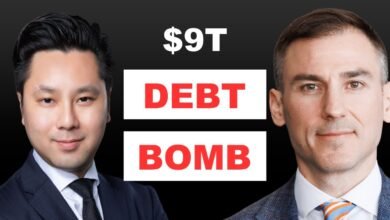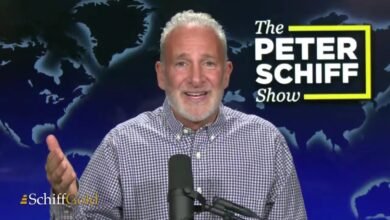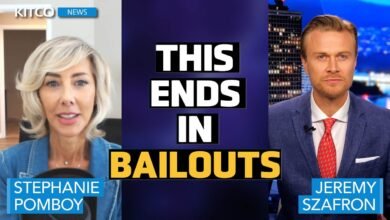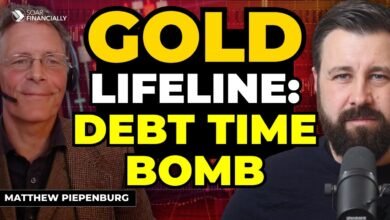Here’s the Shocking Truth About the DOGE Dividend (Uncut) 02-22-2025
Here’s the Shocking Truth About the DOGE Dividend
Donald Trump and Elon Musk just announced the possibility of a doge dividend where every taxpayer would get a check for $5,000. There’s even under consideration a new concept where we give 20% of the doge savings to American citizens and 20% goes to paying down debt. Will this create an economic boom? Will the American taxpayer be $5,000 richer or could it possibly create consumer price inflation? I’m going to reveal the answers in three simple, fast steps.
Step number one, let’s go over the options they have with this doge savings, assuming it actually comes to fruition. That’s an assumption we’re going to make for this video. So I probably should have put savings here instead of dividend, but you guys get what we’re referring to.
So they’ve got an option. Do you make this dividend payment to the taxpayer, or do you take the money to reduce the deficit? Let’s go through these different options. Let’s look at the balance sheet here.
And I think the conclusion is going to surprise a lot of you because the initial reaction is like, yeah, I paid the money, give it right back to me. I totally get it. Like everything, the devil is in the details.
Let’s start by looking at a very simple example. We’ll assume the overall spending, the government spending that is, is $100. We’ll also assume the government stealing, in other words, taxation, is $50.
And then they have to borrow an additional $50 to spend the $100. Now, Elon Musk comes in with doge and the, uh, the big balls. I think that’s what they’re calling the guy.
Okay. But they figure out a way to save $5. So again, they have an option.
Do you distribute this $5 to let’s say taxpayer Tim, or do you reduce the deficit? Or maybe said another way, do you reduce the amount of borrowing? So let’s go ahead and think this through. So this $5 savings means the government would spend $95 of $5 less. Now it is true.
And I kind of put this in parentheses that the overall spending, including the private sector would still be, let’s just say a hundred dollars because likely taxpayer Tim would be able to spend that money on his own. And if given the option between this and what we have today, obviously this is a lot better. That’s for sure.
Because who wouldn’t want the taxpayer to be in control of how they spend their own money? Well, let’s get back to the example. And so if this $5 savings was found by Elon Musk doge and Mr. Big balls himself, then the government spending, like we said, goes down to $95 and the government stealing would go down to $45. But notice the government borrowing would remain the exact same.
And this is crucial to understand. Let’s look at taxpayer Tim’s balance sheet, assuming that the $5 dividend went to him. Well, his assets would increase by $5.
That is true, but the liability side of the balance sheet would also have $5. Why? Because the deficit, the government has to issue the $5 worth of treasuries. In other words, borrow the $5 in order to give it to Tim.
So at the end of the day, if you look at this exclusively through the lens of the balance sheet, Tim is really no better off because he has an additional $5 in assets, but he also has an additional $5 in liabilities. Now, if you’re not following this completely, worry, because by the time we get over here, it’s going to become crystal clear. So let’s go ahead and look at the next example where instead of paying the doge dividend, they’re actually reducing the deficit.
So in this case, you got the $5 of savings right here. Instead of going down to taxpayer Tim, it would go up to reduce this $50. So now the overall spending goes to $95.
The stealing is still at $50, but the borrowing is at 45. So what would happen to taxpayer Tim’s balance sheet? Well, he would not have that $5, nor would he have the $5 of debt. In other words, regardless of whether they do the dividend or the deficit reduction in the short term, just looking at this through the lens of the balance sheet, taxpayer Tim is no better off.
He’s really in the exact same position, but we’re not done yet. Let’s take it one step further. And this is where it gets really exciting and where I would be actually very optimistic.
Let’s assume for a moment that we do not have a deficit because doge is so efficient or increases government efficiency so well, reduces the amount of spending that we no longer have to borrow money, that we are spending whatever we are collecting in taxes, whether it’s tariffs or incomes or property taxes or whatever it is, and we’re not spending one penny more. So we’re not taking on any additional debt. In other words, there is no deficit spending because we have taken all of the savings from doge.
And instead of giving that back to taxpayer Tim, we’ve decreased the deficit. I think I’ve made that pretty clear. So then what would happen is now government spending, let’s say it’s $50 and they find another $5 of savings.
It just continues on and on and on. And then of course we’d reduce the government spending. So it would go down by five bucks.
So now we’re at 45 here, but then we could reduce the amount of stealing the government is doing by the same number that takes us down to 45. So we’re still in balance. But now that $5 goes down to the balance sheet of taxpayer Tim.
And now look at how happy he is. See here and here, he’s kind of indifferent because his balance sheet really doesn’t change. He doesn’t gain any equity.
Even over here, he gets some cash, but he gets an additional liability. But over here he gets the cash, but no additional liability. So again, if we’re looking at this strictly through the lens of the balance sheet, it’s obvious which step should come first.
It’s not the dividend. It’s reducing the deficit because only if the deficit is down to zero, will the savings actually accrue a net benefit to taxpayer Tim. But I want to be crystal, crystal clear because I know a lot of the people are going to misconstrue what I’m saying.
If I had the choice of moving forward with the way we have done things in the United States over the past, who knows, three, four, five, six, seven, 10 decades. I mean, this government waste has been happening. If I had the choice between that and this, I would definitely, definitely take this.
What I’m saying is if you are saving the five bucks, this is suboptimal. What we should shoot for is first this, and then that. Step number two.
So we looked at the dividend versus the deficit reduction through the lens of the balance sheet, but now let’s go ahead and zoom out and look at the economics. To start, let’s look at a chart of GDP, real GDP going back to 1950, but we’re not going to pay any attention to that. We want to focus on what’s happening more recently.
Currently, the real GDP in the United States, right around 23 trillion. So if we were to do a dividend, the doge dividend, then would that impact GDP? Probably not because you’re just taking spending from the government and putting it back into the private sector. Assuming we have the same amount of spending, then with GDP, it’s basically a net wash.
But what would happen if we went ahead and reduced the deficit? Okay, well, we’ve got two components here of the equation, government spending, private sector spending. So that would reduce government spending, private sector spending, assuming that stays the same, GDP would actually go down. We’d have a contraction, which would likely lead to a recession.
And I’m not saying that’s good or bad. Remember, again, we’re just going over the trade-offs here. As Thomas Sowell teaches us, there are no solutions.
There are only trade-offs. So determine which one is better and which one is worse. We’ve got to go through this process.
All right, now let’s look at what it might do to consumer price inflation. So we have to start by asking the question, who is paying all of the taxes that supposedly the doge dividend would reimburse? Well, we look at this chart on the taxfoundation.org, and we can see that about 90% of the taxes paid comes from the top 25% of taxpayers. And then when we look at the bottom 50%, we see that only 2.3% of the income tax, that’s what I’m stating here, is coming from the bottom 50%.
But let’s remember, the doge dividend is just simply a $5,000 payment to every single taxpayer or taxpayer household. So it’s basically a redistribution of wealth very similar to what we saw during the Cervasus sickness. Again, I’m not saying this is better or worse.
We’ve just got to acknowledge that if you sent everyone $5,000, even people that didn’t pay the tax, likely velocity of money would increase because you’re sending that money to people with a higher propensity to spend, a higher propensity to spend in broad areas as opposed to the government spending in very specific areas. As an example, let’s just say USAID or AID was sending $100 billion a year to Ukraine and to all of these other countries. Let’s say they were trying to influence the media and the government.
Okay, well, that’s not really going to increase velocity in the domestic economy in the United States. But if you took that $100 billion and just sent it out to people in the form of what is effectively a then you’re likely going to see velocity increase, aggregate demand goes up relative to the amount of goods and services, and you get a similar situation like we saw in 2021 into 2022 where consumer price inflation, at least of the stuff that you are buying daily, would likely go up significantly. Now, I want to be very clear again.
I’m not saying that this means that the government should be spending it and the people should not be spending it. We’re just looking at this objectively and trying to determine the trade-offs between the two options, the dividend or reducing the deficit. So on that note, let’s think about what would happen to consumer prices if we were to reduce the deficit instead.
All right, well, we talked about GDP contracting, aggregate demand would likely contract, and yes, that would potentially put us into a recession. But if you reduce aggregate demand and keep the supply of stuff at the same level, what would likely happen to prices? They might not go down, but they would go up at a slower rate. Let me show you what I’m referring to.
Let’s look at a chart of the 1970s and consumer price inflation as represented by this red line. And you can see that when we went through economic recessions in the early 1970s and then going into the 1980s, we had actual disinflation. Now, I’m not saying prices went down, but they went up at a lower or slower rate.
And why was this? Because even in a decade that was inflationary, when you have a recession, aggregate demand is going down, is decreasing. Therefore, you likely see prices go down or go up at a slower rate than they otherwise would have, assuming aggregate demand would have stayed the same. So the main takeaways from step number two, just looking at the trade-offs, is the dividend would likely keep GDP the same as it otherwise would have been.
The deficit reduction would likely decrease GDP, potentially putting us into a recession. But then when we look at the inflation, it would likely go up with the dividend. Consumer prices going up, maybe not as much as we saw during the Cervasius sickness, but a similar dynamic, where if we reduced the deficit, we should expect prices maybe not to go down, but be lower than they would have been if we would have done the dividend.
And before we move on to step number three, I want to point out that if we’re looking at this through the lens of what we should do morally, then I believe we should give the money back to the people that put the most in. I know that might not be a popular opinion, so let’s just assume for a moment we’re reimbursing one trillion dollars through this doge dividend. Okay, well, if 25% of the taxpayers paid 90% of the taxes, then they should get 90% of the one trillion dollar reimbursement.
If you don’t do that, then it is just another government redistribution plan. Step number three. So in my opinion, when you do a cost-benefit analysis, it’s much better to reduce the deficit than it is to do what is effectively a central planning type of redistribution scheme.
But the bigger question is how do we get richer as a society? How do we improve the lot for the poor, middle class, the average Joe and Jane? I always use this example in my videos of, we’ll just say the average Joe on a deserted island. We’re going to switch it up a little bit. We’re going to look at it from a different angle to hopefully drive home my point.
So the only thing on this island is a palm tree and five coconuts. Okay, the average Joe is shipwrecked there, let’s say, but he has this treasure chest full of $5. And let’s say the natives or whoever owns this coconut tree is saying, hey, we’ll sell you those five coconuts, Joe.
Well, what do you think the price of those coconuts is going to adjust to? Well, most likely $1 per coconut. He’s got five bucks. Okay.
But now let’s assume for a moment the average Joe was shipwrecked, not with $5, but let’s assume he was shipwrecked with $5,000. Now, what would the price of each coconut adjust to? $1,000. So is Joe any better off? No, because after the prices adjust, he still has the exact same purchasing power.
He still has those five coconuts. So what would make Joe richer? If he had more coconuts, if there was a supply of more coconuts, you see? So in the future, when you’re trying to determine if something is going to be a net benefit to society, I would strongly encourage you to start by asking the question, is it going to result in society at large having access to more goods and services? So would this dividend result in society having access to more goods and services? Probably not. How about a tariff? Maybe, but we would have to produce a lot of coconuts in the United States to make up for the coconuts we are currently importing into the United States.
And how about reducing regulation? If we reduce regulation, bureaucracy, red tape, and unshackle the American entrepreneur, do you think they’re going to be able to produce a whole hell of a lot more than five coconuts? I think the answer is absolutely. And society as a whole will become richer. This is how you benefit the poor, the middle class, and the average Joe and Jane.
So George Gammon would much prefer to focus on this than this or this. Hey guys, I’d like to personally invite each and every one of you to attend this year’s Rebel Capitalist Live. This is the incredible conference I put on annually that helps you build a bulletproof portfolio.
It helps you increase your personal freedom and liberty, and also it helps you increase the size of your network. In other words, you get to meet a lot of like-minded individuals, fellow rebel capitalists. It’s in Orlando, May 23rd through the 25th.
Past speakers have included people like Robert Kiyosaki, Ron Paul, Peter Schiff, Mike Maloney, Lynn Alden, just to name a few. So to get your tickets ASAP and to find out who is speaking at this year’s Rebel Capitalist Live, you can check it out at rebelcapitalistlive.com. And just a little quick insider information, if you get your tickets sooner than later, you can get a discount because as we get closer and closer to the event, the tickets go up in price. So don’t wait, go to rebelcapitalistlive.com right now and get your tickets and I will see you in Orlando, May 23rd through the 25th.




